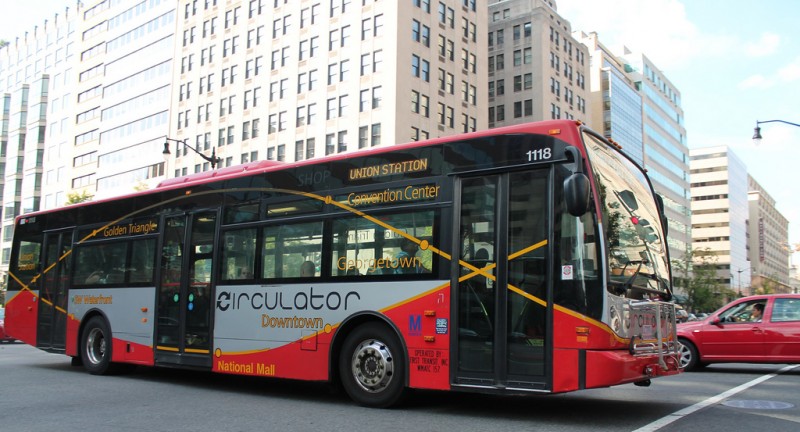DC Circulator woes show why local buses can’t always replace Metrobus

Image by Elvert Barnes on Flickr licensed under Creative Commons.
The private company in charge of running DC Circulator doesn't have the resources to keep enough buses on the streets. The situation suggests some of the thinking behind balkanization of the Washington region's bus network may be faulty.
Why buses are so balkanized
There are more than 20 separate bus providers in the Washington area. WMATA is the largest and covers the most territory, but most counties and large cities have their own. DC has Circulator, Montgomery has Ride On, Arlington has ART, etceteras.
It's all because each jurisdiction pays WMATA to run local Metrobuses, so local officials frequently decide they may as well save money by running those buses as their own systems.

Montgomery Ride-On bus. Image by the author. |

Arlington ART bus. Image by the author. |
And, in theory, locals can indeed pay a lot less.
To calculate how much it costs to operate a bus line, transit agencies use a formula called “cost per revenue hour.” That's simply how much it costs to keep a bus in service and carrying passengers for one hour. It includes the cost of the driver’s salary, fuel for the bus, maintenance, and other administrative costs.
Metrobus's operating cost as of 2011 is $142 per hour. That's unusually high.
For comparison, Fairfax County Connector's is $104/hour. ART's is $72/hour. DC Circulator's is $83.
At those price points, locals can run more buses for less money by contracting out than they can using WMATA. So they do, and thus contracting companies like the one DC uses to run Circulator are born.
If it looks too good to be true, it probably is
$83 may be less than $142, but there are a few big problems with that math. Together, they undermine the logic behind localizing bus lines.
First, WMATA's cost per hour figure includes a lot of back-office and support costs that local figures usually leave out. For example, WMATA has its own police force, which has to be covered in its operating calculations. Local buses on the other hand rely on local police forces, whose budgets typically aren't included in transit figures. Local taxpayers still pay for their police, just not as part of the transit budget. So the math is a little fuzzy.
Second, as Circulator's woes bring to light, private contractors may not provide adequate support, if they won their job by offering a low bid that's not actually enough to sustainably run a system. First Transit, the contractor that runs Circulator, apparently can't afford adequate maintenance facilities or enough qualified maintenance staff to keep the Circulator fleet running. As a result, buses break down much more often than they should, and don't go back into service as quickly or as firmly as we need to maintain regular service.
Thus, many of the savings promised by low hourly rates turn out to be illusory.
DC Circulators buses at First Transit's Ivy City bus yard. Image by the author.
How much of the savings are genuine, and how much aren't? It's hard to tell. A true apples-to-apples comparison doesn't seem to exist, at least not yet. It's only now becoming clear to transit operators how faulty the old numbers really are.
But it seems likely the answer will be that sometimes local buses are authentically cheaper, and sometimes they aren't. To get to the bottom of it, we're going to need a lot more information.
